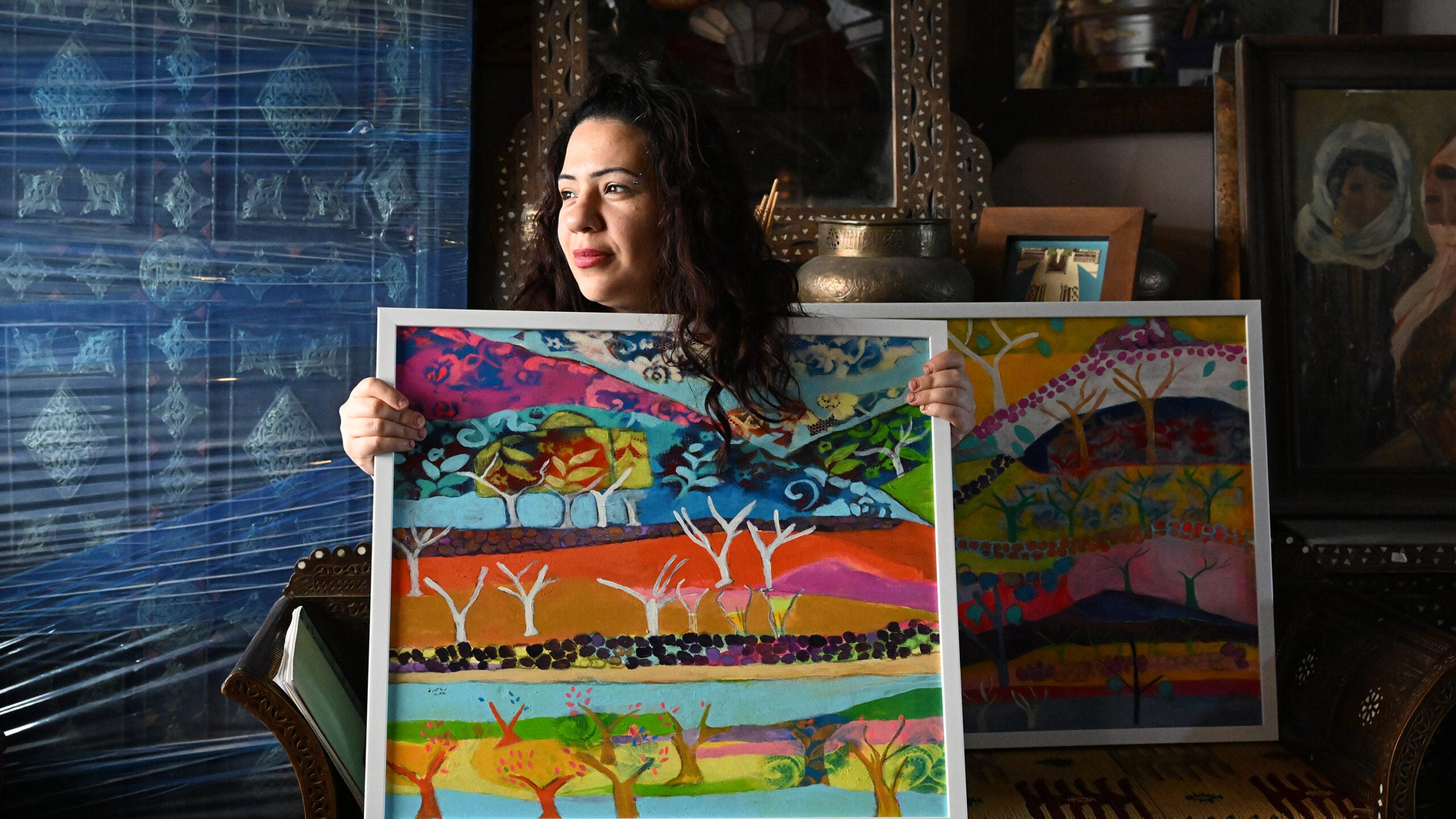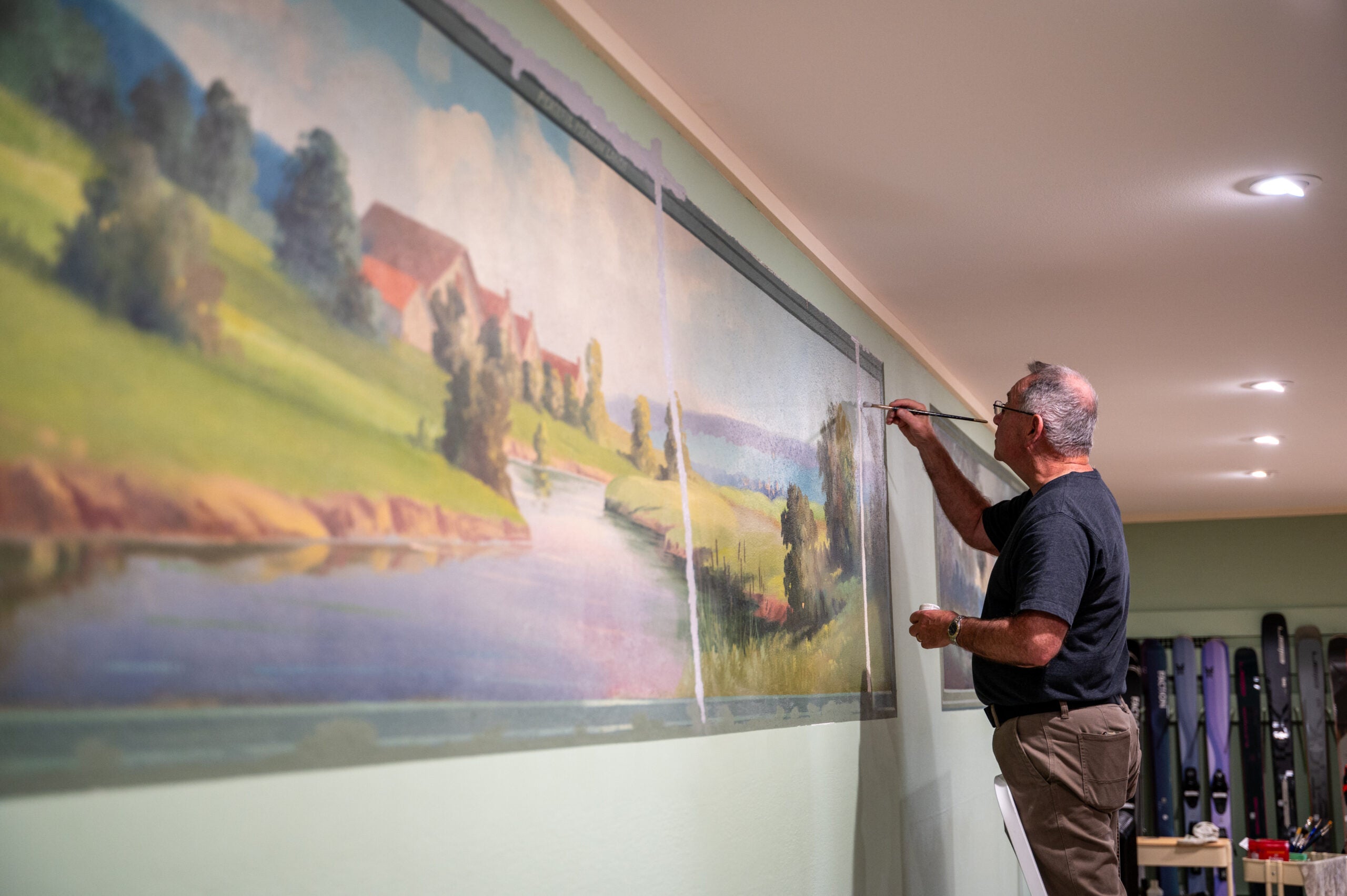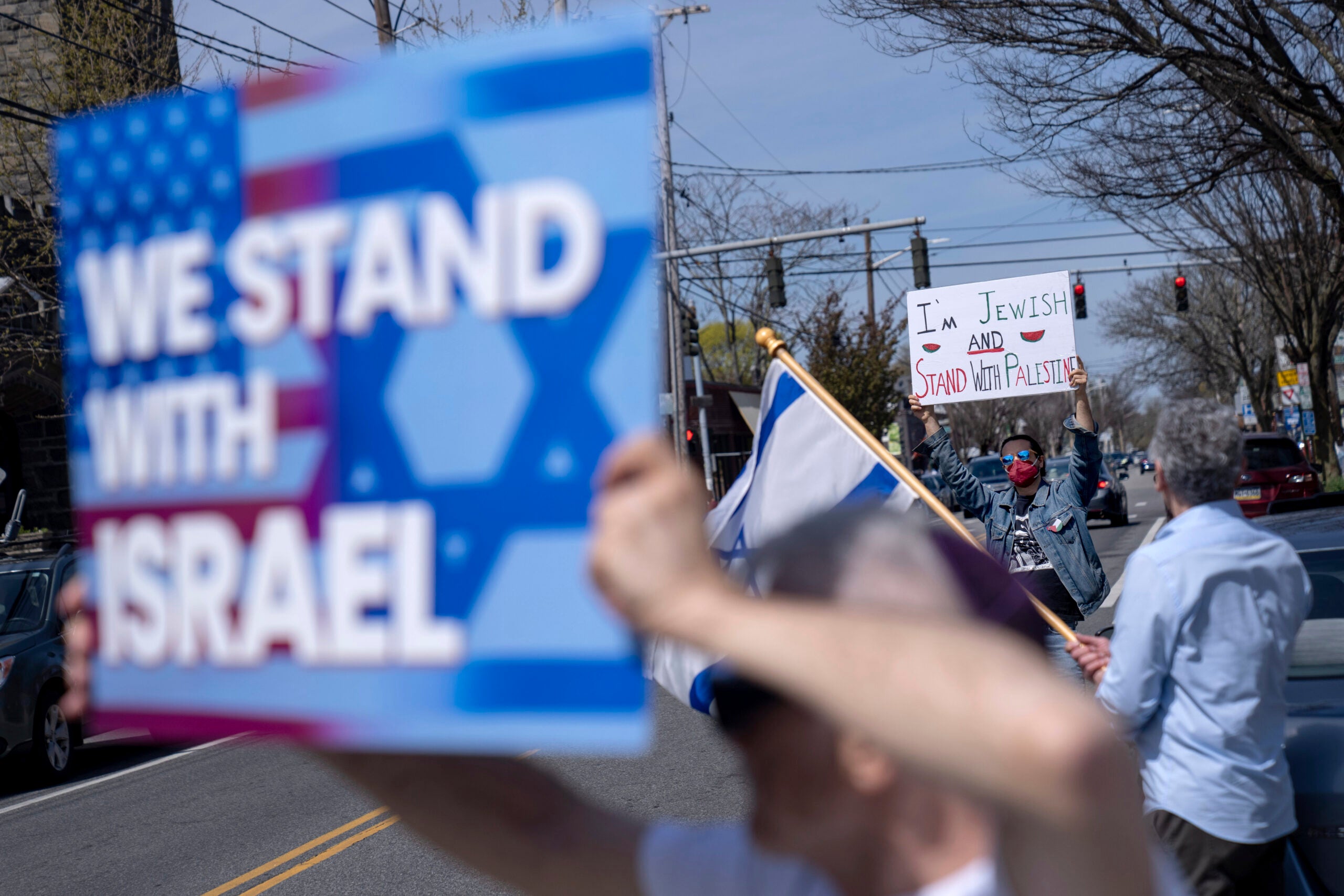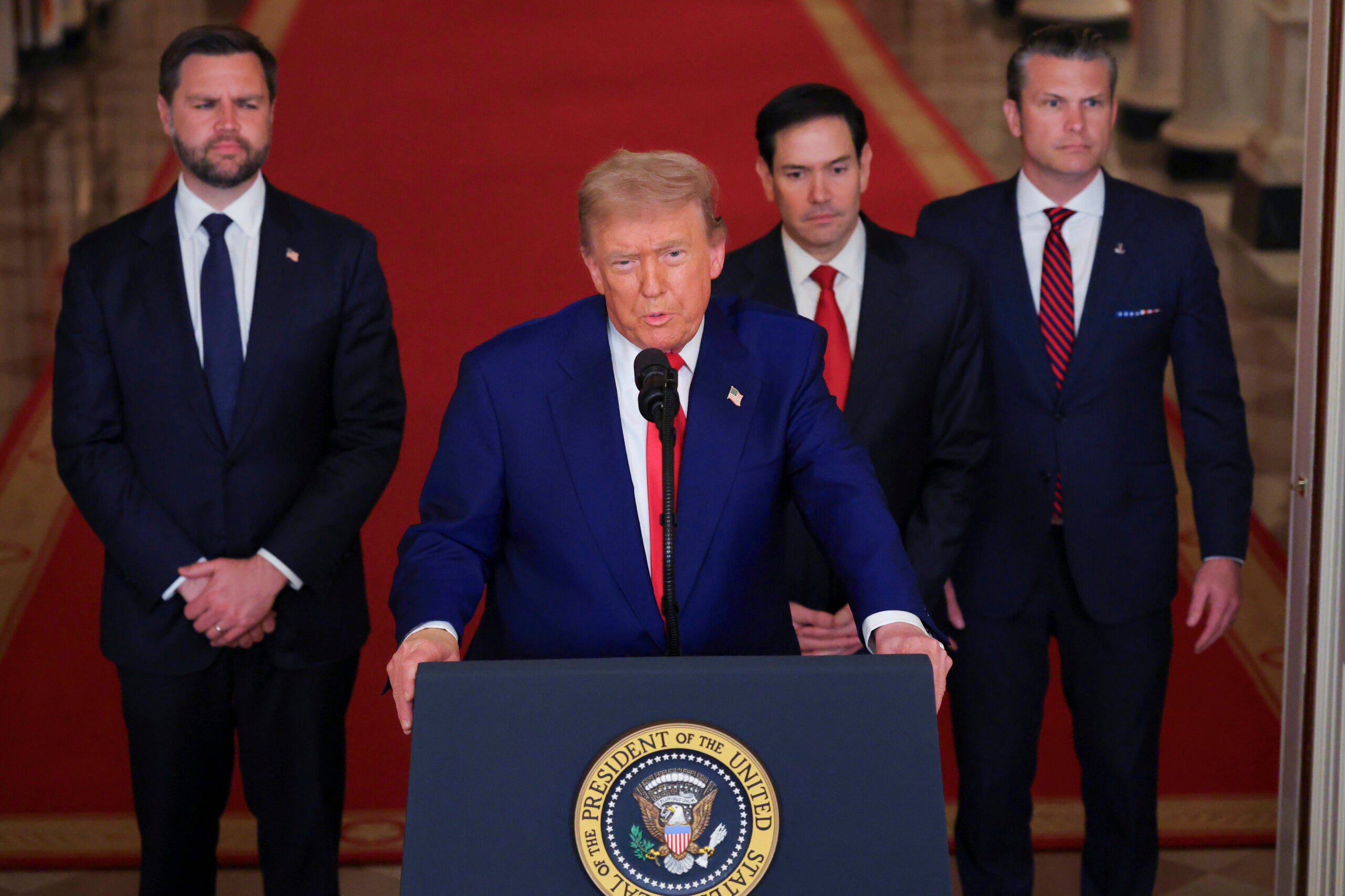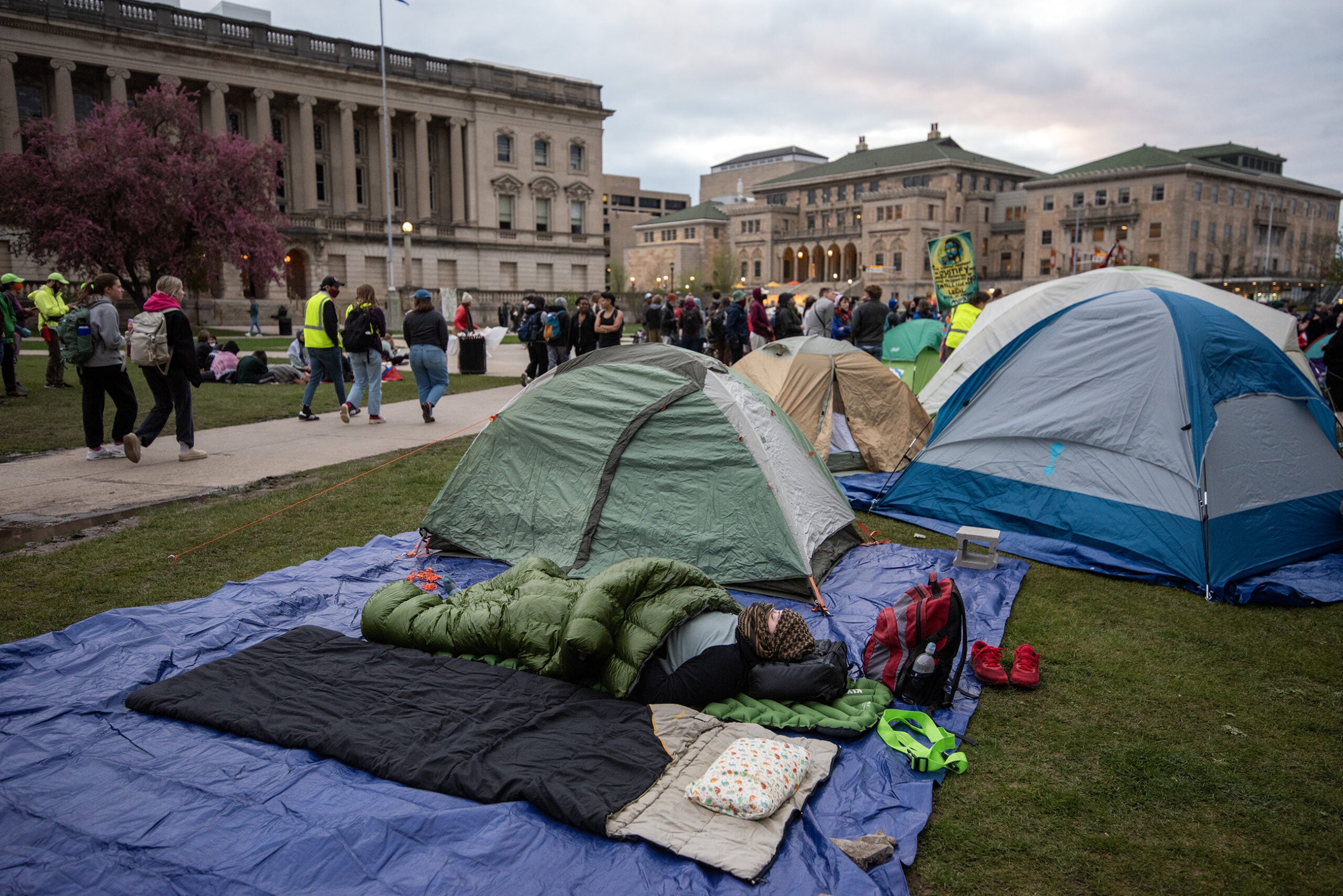In Israel’s cultural capital of Tel Aviv, a vibrant artistic community leaves its colorful mark with murals and other art painted throughout the narrow streets of the city’s ancient Jaffa neighborhood and on the walls of businesses within the financial-centered downtown.
Within this same space is a Palestinian community that has long turned to art as a form of resistance, using it to bring light to the struggles of Palestinians in Tel Aviv, the Israeli-occupied West Bank and Gaza.
Since Oct. 7, much of this work has turned heartbroken, mournful, angry and fearful, as members of these artistic communities confront heavy, unimaginable emotions that are bleeding into their craft.
News with a little more humanity
WPR’s “Wisconsin Today” newsletter keeps you connected to the state you love without feeling overwhelmed. No paywall. No agenda. No corporate filter.
More than 1,200 people in Israel were killed on that day and hundreds of others were kidnapped by Hamas. In response, Israel launched a now months-old war in Gaza that has killed more than 22,000 Palestinians and displaced nearly two million others.
Artists are processing the crisis in a myriad of ways: through paintings of the horrors of war, through anguished song and in dance. The work has been shared in places like Tel Aviv’s Hostages Square, where protesters regularly gather to demand the release of Israeli captives being held by Hamas, and on social media, where a Palestinian diaspora say they can more safely post their work than those still living under the Israeli government.
“I think that if art can function as something, not only for the viewer, but for myself, it’s to create a space for reflection and reassessing and trying to dissect and process and understand,” said Addam Yekutieli, an Israeli artist based in Tel Aviv.
NPR spoke to Yekutieli and five other Israeli and Palestinian artists on how the war between Israel and Hamas has affected their lives and their work.
Each artist took time to reflect on Oct. 7 and its aftermath, sharing stories of fear, anger, sadness and pain.
Rana Samara
“In times of stress, usually people go for black, people go for dark colors,” said Rana Samara, a Palestinian artist from Ramallah in the Israeli-occupied West Bank. “I found that now, my stress has come out with very, very, very bright colors.”
Samara’s work frequently uses bright paintto explore topics like sexuality, gender roles and other issues tied to Palestinian life. When war broke out in Gaza, she decided to turn to the images she was seeing on TV and social media and weave it into her work.
Samara is part of a group of Palestinian artists that joined with the Zawyeh Gallery in Ramallah to create work to help raise money for humanitarian aid in Gaza.
“What caught my mind and heart in what I was watching about this war was the issue of children. And so I looked and I concentrated on what each child was carrying” as they evacuated their homes in Gaza, she said.
For one piece, Samara decided to create a type of poster of these different scenes of children fleeing their homes using bright reds and pinks. Using the image of the children’s piggy bank, for example, she incorporated the war.
“My idea was a piggy bank and inside a tank,” she said. At first look, it’s an attractive, colorful, bright picture, “but when you get close to it, it’s the bleak image. It’s the tank.”
Michal Worke
Before Oct. 7, many of Michal Worke’s paintings had rich purples and vibrant patterns that reflected her travels in Ethiopia and South Africa.
But now, the colors in her latest works are muted with blues and grays.
“It started with the shock of the kidnappings, and the murders and disasters,” she said of the attack by Hamas militants.
Worke, who is a Jewish Israeli of Ethiopian descent, found that the footage on social media and on the news of the attack wove itself into her psyche.
“I think I responded like everyone to the trauma that we saw. It was really hard for me. I started having dreams that they are coming for me, and they start shooting and I didn’t know where to hide or where to go,” she said.
In the early days after the attack, Worke said she was avoiding the studio and turning more inward to collect her thoughts and take stock of her emotions.
Worke is a painter that has long advocated for the release of Avera Mengistu, a fellow Israeli of Ethiopian descent that has been in Hamas custody for nine years. She regularly paints Mengistu and his family, sharing her work online.
Since Oct. 7, she’s seen the abundance of artwork created in honor of the fallen and the more than 240 hostages taken by Hamas that day, of which more than 100 remain in captivity.
“But not for Avera. He isn’t there, his face isn’t anywhere,” she said.
So, in response she’s worked to continue to amplify Mengistu’s story so that he isn’t forgotten.
Worke has also begun painting other things about the war and the interconnectedness she is finding between the war and her Ethiopian community.
“Many Ethiopian soldiers have died,” she said. “Ninety percent of Ethiopians [in Israel] go to combat units. It’s the highest percentage of any community. So many have died.”
She’s incorporated the untold stories of Israeli soldiers of Ethiopian descent fighting in Gaza into works that also raise awareness for Mengistu.
In one piece, a soldier dressed in his uniform is sitting comfortably by a fence splitting southern Israel with Gaza. On the margins, Worke includes the number of days Mengistu has been in custody. Along the ground of the painting are pieces of bloodstained uniforms.
“This is from a series of larger paintings I’m working on. And you can see the jump between this painting and the others. The difference in the colors and the themes,” she said. “These paintings were done only three months apart.”
Bashar Murad
Bashar Murad has long used pop music as a tool to express his experience as a Palestinian born within the “oppression” of the Israeli government, he said.
“I create pop music that kind of reflects my experience as a human born in this place and all the complexities that come with being born in this place,” he says. “I believe in the power of pop music to reach the masses to help share and spread messages of equality and love, which is what pop music is all about.”
Murad frequently used social media to share his music and thoughts. That all changed shortly after war broke out in Gaza.
He said the feelings of depression and shock that struck him in the hours and days that followed left him homebound and essentially bed-ridden.
“For the first 20 days, I didn’t go out of my room, basically,” he said.
“The sad thing is that for a lot of people in the world, this feels like it’s the first time that these events are happening,” Murad said. “We have gone through a cycle of this ongoing violence. I’ve already written countless songs already throughout the years that actually talk about the same feeling that I’m feeling now. Maybe now it is times 1 million. But it’s the same feeling. It’s the same feeling of powerlessness and helplessness.”
This time there also emerged a new level of fear that Murad and other Palestinian artists hadn’t quite felt before. After the war began, Palestinians in Israel reported discrimination, firings and other threats of violence for simple social media posts criticizing the war.
That scared many Palestinians in Israel, the West Bank and Gaza into silence, Murad said.
“It’s very dangerous for us artists, right now. There’s major censorship that is happening,” he said. “There is a war on the ground, there’s a war on social media, but there’s also a mental war and a war on our identities.”
Murad said he is trying to “be smarter with what I post” — a sentiment that Samara, the painter in Ramallah, also shared.
He said the fighting is not just a war with Gaza, “It’s a war on all Palestinians and all Palestinian identity.” He called it a “continuous struggle,” adding, “it’s not something that starts with an attack and ends with a ceasefire.”
Addam Yekutieli
“In how many ways can your heart break?”
“Whose trauma speaks louder than whose?”
“Can we ever be well?”
These are questions Addam Yekutieli has had rolling around in his mind ever since Oct. 7.
Yekutieli is a multidisciplinary artist based in Tel Aviv. In his ongoing projects, he has reflected on the ideas of scars and borders and the effect they have on people geographically, physically and psychologically.
“I’ve always dealt with kind of like political or social themes, but for a very long time, they were much more metaphorical than they are now,” he said.
Yekutieli, like Worke, found it difficult to return to his normal workload after Oct. 7. About a month after the attacks, Yekutieli spoke about how his work has changed since the outbreak of the war.
“I haven’t really made any art since October 7,” he said in November. “I’ve been mainly writing since then.”
And what he’s been writing is a long list of questions he has on his mind and has shared it on social media. He calls these posts “questions with no answers.”
“Over the past month and a half, I’ve had so manyinternal conversations and dialogues and kind of been really like talking myself into circles,” he said.
He posts questions like “What are your five stages of grief?” and “If you had it your way, what would happen?”
“I think that I just feel more comfortable with asking questions more than making statements. They feel more honest. It feels more of an authentic place to be in. And, I think that it also allows more reflection,” he said.
He said the tragedy shook him on a foundational level.
“I think that there are parts of me that feels very naïve. But it feels like everything is spiraling out of control, and becoming progressively worse and worse,” he said.
Yekutieli acknowledged that as an Israeli artist he has a level of privilege to more comfortably share his thoughts and questions on a public domain like Instagram than his Palestinian artist peers who fear reprisal for doing so.
He believes a lot of the hostility toward Palestinians, activists and Israelis critical of their government comes from a place of deep desperation and grief.
“I think that things are very, very emotional,” he said. “And at the same time, I really think that it’s important, as much as we can, and as much as one feels comfortable with, to keep on being vocal.”
Hanna Tams
Dance has always been a source of healing for Hanna Tams, a professional dancer that specializes in contemporary and dabka styles.
As a Palestinian living in Jerusalem, Tams has faced oppression his whole life, he said. After the war broke out, it became even more complex and tense than before, he said.
“I was lucky to find dance as a friend,” he said. “I can resist through dancing. Other people don’t have this luxury.”
Tams is the founder of Douban Art Studio, which he opened in 2020 to serve his community’s youth to work through their emotions and struggles in a safe way.
But after Oct. 7, he retreated into himself and closed the studio for two weeks.
“I really wasn’t able to do anything and I wasn’t feeling up to dance. I was sick,” he said.
It was the community he’s worked to serve that reached out to beg him to reopen and help the kids stuck at home.
They told him, “‘It’s the kids who are suffering. The kids have no school, they are at home and they are watching TV with us. They are afraid,’” Tams said.
He reopened the studio, but not without difficulty. The studio is in East Jerusalem, in an area where Israeli soldiers constantly patrol the streets and stop Palestinian residents.
“It’s really frightening because every time I will be approached by a soldier who starts asking me why you’re coming here and you’re not allowed,” he said.
In November, Tams was able to perform in a timely show in Switzerland called “Last Things Remaining.” The show involved four dancers telling the story of Palestinians and the resilience it takes to live in this region.
He returned saying, “I need to serve this community. I need to serve these people who don’t have anything.”
When asked how he could still turn to art and especially dance in such a hard time, he said,”For me, the only way I can really help and I can really kind of connect, it’s [through] dancing.”
He continued, “I think art is kind of the language of every culture, and it’s the language of hearts. So if you want to [get at] every heart, I think art is needed.”
Oren Fischer
After the war started, Oren Fischer said he reached a point where he just couldn’t deal with any more words.
“So I started painting,” he said.
In the first two weeks after the attacks, Fischer said he slept horribly and had nightmares based on what he was seeing on TV and social media.
He decided to make a change: Instead of doom scrolling each morning, Fischer would instead wake up and meditate on his feelings and “just try to puke it on the papers.”
Fischer, an artist who uses different mediums in his work like video, illustration and textiles, has been using paint and crayon in his sketchbook for these daily pieces. He describes his paintings as “childish” and “naïve” in a way even as it portrays horrors of the Oct. 7 attacks and the war.
“I thought, okay, if it’s bothering me, it’s probably something people really relate to. It’s probably not just me thinking about this,” he said.
“It helped me to heal myself. I made sort of a routine that I wake up and for a few hours I paint and upload on social media,” he said. “So I created my own world inside the catastrophe.”
Like much of his past work, this series of paintings has been deeply critical of Israeli Prime Minister Benjamin Netanyahu and his government, blaming their policies as the spark that led to the attack.
Fischer painted a sketch of Netanyahu with vibrant reds, yellows, oranges and blues of the prime minister with blood on his hands. In the background are Hamas attackers shooting people and homes burning. The image was later used on the cover of an Israeli newspaper.
Fischer said his work has been criticized by some people who misunderstood his sketches as him attacking Palestinians, when the work is really turning criticism to the Israeli government.
Ultimately, Fischer said the impact of the attacks and the ongoing war “is everywhere.You cannot hide from it.”
NPR’s Jaclyn Diaz reported from Tel Aviv, Ramallah and Jerusalem. Freelance producer Eve Guterman contributed to this report.
9(MDAyMjQ1NTA4MDEyMjU5MTk3OTdlZmMzMQ004))
© Copyright 2025 by NPR. To see more, visit https://www.npr.org.9(MDAyMjQ1NTA4MDEyMjU5MTk3OTdlZmMzMQ004))

